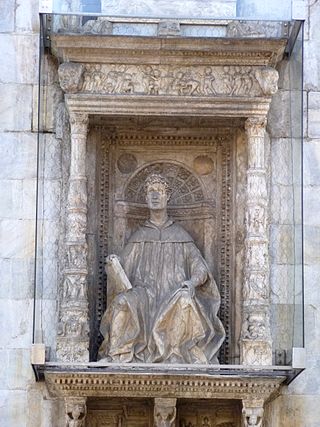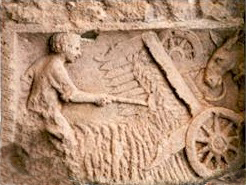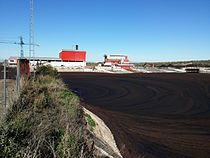
Olive oil is a liquid fat obtained by pressing whole olives, the fruit of Olea europaea, a traditional tree crop of the Mediterranean Basin, and extracting the oil.

A Roman villa was typically a farmhouse or country house built in the Roman Republic and the Roman Empire, sometimes reaching extravagant proportions.

Gaius Plinius Caecilius Secundus, born Gaius Caecilius or Gaius Caecilius Cilo, better known as Pliny the Younger, was a lawyer, author, and magistrate of Ancient Rome. Pliny's uncle, Pliny the Elder, helped raise and educate him.

Marcus Porcius Cato, also known as Cato the Censor, the Elder and the Wise, was a Roman soldier, senator, and historian known for his conservatism and opposition to Hellenization. He was the first to write history in Latin with his Origines, a now fragmentary work on the history of Rome. His work De agri cultura, a rambling work on agriculture, farming, rituals, and recipes, is the oldest extant prose written in the Latin language. His epithet "Elder" distinguishes him from his great-grandson Cato the Younger, who opposed Julius Caesar.
Marcus Verrius Flaccus was a Roman grammarian and teacher who flourished under Augustus and Tiberius.
A latifundium is a very extensive parcel of privately owned land. The latifundia of Roman history were great landed estates specializing in agriculture destined for export: grain, olive oil, or wine. They were characteristic of Magna Graecia and Sicily, Egypt, Northwest Africa and Hispania Baetica. The latifundia were the closest approximation to industrialized agriculture in Antiquity, and their economics depended upon slavery.

Cornelius Nepos was a Roman biographer. He was born at Hostilia, a village in Cisalpine Gaul not far from Verona.

Lucius Junius Moderatus Columella was a prominent writer on agriculture in the Roman Empire.

Roman commerce was a major sector of the Roman economy during the later generations of the Republic and throughout most of the imperial period. Fashions and trends in historiography and in popular culture have tended to neglect the economic basis of the empire in favor of the lingua franca of Latin and the exploits of the Roman legions. The language and the legions were supported by trade and were part of its backbone. The Romans were businessmen, and the longevity of their empire was caused by their commercial trade.

Roman agriculture describes the farming practices of ancient Rome, during a period of over 1000 years. From humble beginnings, the Roman Republic and the Roman Empire expanded to rule much of Europe, northern Africa, and the Middle East and thus comprised many agricultural environments of which the Mediterranean climate of dry, hot summers and cool, rainy winter was the most common. Within the Mediterranean area, a triad of crops were most important: grains, olives, and grapes.

Olive oil extraction is the process of extracting the oil present in olive drupes, known as olive oil. Olive oil is produced in the mesocarp cells, and stored in a particular type of vacuole called a lipo vacuole, i.e., every cell contains a tiny olive oil droplet. Olive oil extraction is the process of separating the oil from the other fruit contents. It is possible to attain this separation by physical means alone, i.e., oil and water do not mix, so they are relatively easy to separate. This contrasts with other oils that are extracted with chemical solvents, generally hexane. The first operation when extracting olive oil is washing the olives, to reduce the presence of contaminants, especially soil which can create a particular flavor effect called "soil taste".
Edaphology is concerned with the influence of soils on living beings, particularly plants. It is one of two main divisions of soil science, the other being pedology. Edaphology includes the study of how soil influences humankind's use of land for plant growth as well as people's overall use of the land. General subfields within edaphology are agricultural soil science and environmental soil science.

De agri cultura, written by Cato the Elder, is the oldest surviving work of Latin prose. Alexander Hugh McDonald, in his article for the Oxford Classical Dictionary, dated this essay's composition to about 160 BC and noted that "for all of its lack of form, its details of old custom and superstition, and its archaic tone, it was an up-to-date directed from his own knowledge and experience to the new capitalistic farming." Cato was revered by many later authors for his practical attitudes, his natural stoicism and his tight, lucid prose. He is much quoted by Pliny the Elder, for example, in his Naturalis Historia.
In Ancient Rome, carmen was generally used to signify a verse, but in its proper sense, it referred to a spell or prayer, form of expiation, execration, etc. Surviving examples include the Carmen Arvale and the Carmen Saliare.

Ceterum (autem) censeo Carthaginem esse delendam, often abbreviated to Carthāgō dēlenda est, is a Latin oratorical phrase pronounced by Cato the Censor, a politician of the Roman Republic. The phrase originates from debates held in the Roman Senate prior to the Third Punic War between Rome and Carthage. Cato is said to have used the phrase as the conclusion to all his speeches to push for the war.
Oxymel is a mixture of honey and vinegar, used as a medicine.

The history of the wine press and of pressing is nearly as old as the history of wine itself with the remains of wine presses providing some of the longest-serving evidence of organised viticulture and winemaking in the ancient world. The earliest wine press was probably the human foot or hand, crushing and squeezing grapes into a bag or container where the contents would ferment.

Grape syrup is a condiment made with concentrated grape juice. It is thick and sweet because of its high ratio of sugar to water. Grape syrup is made by boiling grapes, removing their skins, squeezing them through a sieve to extract the juice. Like other fruit syrups, a common use of grape syrup is as a topping to sweet cakes, such as pancakes or waffles.
Gagae or Gagai was a town on the southeast coast of ancient Lycia, in what is now the province of Antalya, from which the Gagates lapis derived its name. The ruins are located in Kumluca district, Antalya Province, Turkey. Excavations in 2007 revealed an upper and lower acropolis and evidence of Rhodian colonization.
Livia Drusa was a Roman matron. She was the daughter of Marcus Livius Drusus, consul in 112 BC, and sister of Marcus Livius Drusus, tribune of the plebs in 91 BC. She was the mother of Cato the Younger, and grandmother of Marcus Junius Brutus, through her oldest daughter Servilia.














